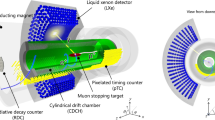Abstract
Colliding beams experiments in High Energy Physics rely on solid state detectors to track the flight paths of charged elementary particles near their primary point of interaction. Reconstructing tracks in this region requires, per collision, a partitioning of up to 103 highly correlated observations into an unknown number of tracks. We report on the successful implementation of a combinatorial track finding algorithm to solve this pattern recognition problem in the context of the ALEPH experiment at CERN. Central to the implementation is a 5-dimensional axial assignment model (AP5) encompassing noise and inefficiencies of the detector, whose weights of assignments are obtained by means of an extended Kalman filter. A preprocessing step, involving the clustering and geometric partitioning of the observations, ensures reasonable bounds on the size of the problems, which are solved using a branch & bound algorithm with LP relaxation. Convergence is reached within one second of CPU time on a RISC workstation in average.
Similar content being viewed by others
References
Ahuja, R.K., Magnanti, T.L. and Orlin, J.B. (1993), “Network Flows”, Prentice Hall.
Bar-Shalom, Y. and Fortman, Th.E. (1988), “Tracking and Data Association”, Mathematics in Science and Engineering, Academic Press.
Berkelaar, M.R.C.M., LP_SOLVE 2.0, Eindhoven University of Technology, Eindhoven, The Netherlands, Package available via anonymous ftp at ftp.es.ele.tue.nl/pub/lp_solve/.
Blackman, S.S. (1986), “Multiple-Target Tracking with Radar Applications”, Artech House.
Bonissent, A. and Thulasidas, M. (1994), “A New Simulation Program for the Present and Upgraded VDET”, ALEPH Note, 94–152, CERN, Geneva.
Brown, D. (1992), “Tagging b Hadrons using Track Impact Parameters”, ALEPH Note 92–135, CERN, Geneva.
Buskulic, D., et al. (ALEPH Collaboration) (1995), “Performances of the ALEPH detector at LEP”, Nuclear Instr. & Methods, A360, 481–506.
Cassel, D.G. and Kowalsky, H. (1981), “Pattern Recognition in Layered Track Chambers Using a Tree Algorithm”, Nuclear Instr. & Methods, 185, 235–251.
Catlin, D.E. (1989), “Estimation, Control, and the Discrete Kalman Filter”, Applied Mathematical Sciences 71, Springer-Verlag.
Comas, P., Knobloch, J. and Pusztaszeri, J.F., eds. (1996), “ALEPH Event Reconstruction Manual”, ALEPH Internal Report, 96–010, CERN, Geneva.
Decamp, D. et al. (ALEPH Collaboration) (1990), “ALEPH: A Detector for Electron-Positron Anihilations at LEP”, Nuclear Instruments & Methods A294, 121–178.
Gyulassy, M. and Harlander, M. (1991), “Elastic Tracking and Neural Networks for Complex Pattern Recognition”, Computer Physics Communications, 66, 31–46.
Morefield, Ch.L. (1977), “Application of 0–1 Integer Programming to Multitarget Tracking Problems”, IEEE Transactions on Automatic Control, vol. AC-22, no. 3. 302–312.
Nemhauser, G.L. and Wolsey, L.A. (1988), “Integer and Combinatorial Optimization”, Wiley.
Nemhauser, G.L., et al., eds. (1989), “Handbook of Operations Research and Management Science”, vol.1, North-Holland.
Papadimitriou, C.H. and Steiglitz, K. (1982), “Combinatorial Optimization: Algorithms and Complexity”, Prentice-Hall.
Pardalos, P.M., Pitsoulis, L. and Resende, M.G.C. (1995), A Parallel GRASP Implementation for the Quadratic Assignment Problem. In Solving Irregular Problems in Parallel: State of the Art, A. Ferreira and J. Rolim, eds., Kluwer Academic Publishers, 111–128.
Pardalos, P.M. and Wolkowicz, H., eds. (1994), Quadratic Assignment and related problems. DIMACS Series in Discrete Mathematics and Theoretical Computer Science. Vol. 16, American Mathematical Society.
Particle Data Group (1994), “Review of Particle Properties”, Physics Review D, Particles and Fields, 50.
Peterson, C. and Anderson, J.R. (1987), “A Mean Field Theory Learning Algorithm for Neural Networks”, Complex Systems Publications, 66, 31–46.
Peterson, C. (1989), “Track Finding with Neural Networks”, Nuclear Instruments & Methods, A 279, 537–545.
Poore, A.B. (1994), “Multidimensional Assignment Formulation of Data Association Problems Arising from Multitarget Tracking and Multisensor Data Fusion”, Computational Optimization and Applications, 3, 27–57.
Poore, A.B. and Rijavec, N. (1993), “A Lagrangian Relexation Algorithm for Multidimensional Assignment Problems arising from Multitarget Tracking”, SIAM Journal of Optimization, vol. 3, no.3, 544–563.
Poore, A.B. and Rijavec, N. (1994), “A Numerical Study of Some Data Association Problems Arising in Multitarget Tracking”, in Large Scale Optimization: State of the Art, W. W., Hager, D. W., Hearn and P. M., Pardalos, editors, Kluwer Academic Publishers B. V., Boston, 339–361.
Pusztaszeri, J.F., “Pattern Recognition in a Proportional Wire Drift Chamber”, work in progress.
Reid, D.B. (1979), “An Algorithm for Tracking Multiple Targets”, IEEE Transactions on Automatic Control, vol. AC-24, no.6.
Scott, W.T. (1963), “The Theory of Small-Angle Multiple Scattering of Fast Charged Particles”, Reviews of Modern Physics, vol. 35, no.2, 231–313.
Stimpfl-Abele, G. and Garrido, L. (1991), “Fast Track Finding with Neural Networks”, Computer Physics Communications, 64, 46–56.
Author information
Authors and Affiliations
Rights and permissions
About this article
Cite this article
Pusztaszeri, JF., Rensing, P.E. & Liebling, T.M. Tracking elementary particles near their primary vertex: A combinatorial approach. J Glob Optim 9, 41–64 (1996). https://doi.org/10.1007/BF00121750
Received:
Issue Date:
DOI: https://doi.org/10.1007/BF00121750




